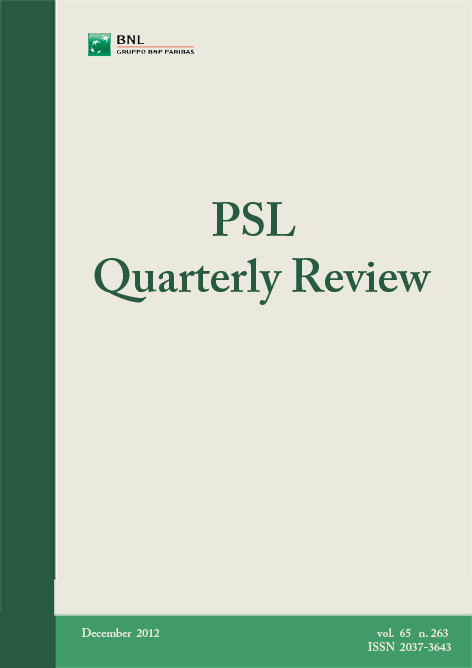Keynesian uncertainty and the shaky foundations of statistical risk assessment models
DOI:
https://doi.org/10.13133/2037-3643/10197Keywords:
risk assessment, probability, uncertainty, financial regulationAbstract
With the financialization of the economy, increasing reliance has been put on statistical models for derivatives pricing and for risk assessment in the day-to-day business of financial operators as well as in financial regulation. This practice had already been criticized from many quarters and on different accounts before the crisis, but these criticisms were simply ignored by the prevailing consensus. This work reconsiders such criticisms from a different standpoint: though they are justified, they could have been put forward in even stronger terms had they relied on Keynes’s work on probability and his notion of uncertainty. I shall thus focus on the conceptual views underlying statistical risk assessment techniques rather than on the techniques in themselves. Finally, I set out some policy implications for regulation.
JEL Codes: G32, D81, E12
References
BANCA D’ITALIA (2012), Rapporto sulla stabilità finanziaria, n. 4.
CANNATA F., CASELLINA F. and GUIDI G. (2012), “Inside the Labyrinth of Basel Risk-Weighted Assets: How Not to Get Lost”, Occasional Papers, n. 132, Banca d’Italia, Rome.
COOPER G. (2008), The Origin of Financial Crises, New York: Random House.
DANIELSSON J. (2002), “The Emperor Has No Clothes: Limits to Risk Modeling”, Journal of Banking and Finance, vol. 26 n. 7, pp. 1273-1296.
DANIELSSON J.(2008), “Blame the Models”, Journal of Financial Stability, vol. 4 n. 4, pp. 321-328.
DE FINETTI B. (1930), “Fondamenti logici del ragionamento probabilistico”, Bollettino dell’Unione Matematica Italiana, vol. 9, pp. 258-261.
DE FINETTI B. (1931), Probabilismo: Saggio critico sulla teoria della probabilità e sul valore della scienza, Naples: Perrella.
D’IPPOLITI C. and RONCAGLIA A. (2011), “L’Italia: una crisi nella crisi”, Moneta e Credito, vol. 64 n. 255, pp. 189-227.
FAMA E. (1970), “Efficient Capital Markets: A Review of Theory and Empirical Work”, The Journal of Finance, vol. 25 n. 2, pp. 383-417.
FORNI M. and LIPPI M. (1997), Aggregation and the Microfoundations of Dynamic Macroeconomics, Oxford: Oxford University Press.
GORTON G.B. (2010), Slapped by the Invisible Hand: The Panic of 2007, Oxford: Oxford University Press.
HALDANE A.G. (2012), “The Dog and the Frisbee”, Federal Reserve Bank of Kansas City's 36th economic policy symposium ‘The Changing Policy Landscape’, 31 August 2012, Jackson Hole, Wyoming.
HARCOURT G.C. (1972), Some Cambridge Controversies on the Theory of Capital, Cambridge: Cambridge University Press.
HUME D. (1939-40), A Treatise of Human Nature, London: John Noon.
KEYNES J.M. (1921), A Treatise on Probability, London: Macmillan.
KEYNES J.M. and SRAFFA P. (1938), “Introduction” in Hume D. [1740], An Abstract of a Treatise of Human Nature, Cambridge: Cambridge University Press, pp. v-xxxii.
KNIGHT F.H. (1921), Risk, Uncertainty and Profit, Boston: Houghton Mifflin.
LUCAS R. (2003), “Macroeconomic Priorities”, American Economic Review, vol. 93 n. 1, pp. 1-14.
MANDELBROT B. (1997), Fractals and Scaling in Finance: Discontinuity, Concentration, Risk, New York: Springer.
MASERA R. (2012), “Risk, Regulation and Supervision of Financial Systems: US and Eurozone Solutions”, Zeitschrift für öffentliches Recht, vol. 67 n. 2, pp. 253-282.
MINSKY H. (1982), Can “It” Happen Again? Essays on Instability and Finance, Armonk: Sharpe.
MONTANARO E. and TONVERONACHI M. (2012), “Financial Reforms at a Crossroads: A European Perspective for a Radical Reform Building on Minsky’s Approach”, PSL Quarterly Review, vol. 65 n. 263, pp. XXX-XXX.
POPPER K. (1969), Conjectures and Refutations, London: Routledge & Kegan Paul.
RAMSEY F. (1931), The Foundations of Mathematics, London: Routledge & Kegan Paul.
RONCAGLIA A. (2009), “Keynes and Probability: An Assessment”, The European Journal of the History of Economic Thought, vol. 16 n. 3, pp. 489-510.
ROUBINI N. and MIHM S. (2010), Crisis Economics, New York: Penguin.
SAVAGE L.J. (1954), The Foundations of Statistics, New York: Wiley.
SOROS G. (2008), The New Paradigm for Financial Markets, New York: Public Affairs.
TALEB N.N. (2001), Fooled by Randomness: The Hidden Role of Chance in Life and in the Market, New York: Random House.
TALEB N.N. (2007), The Black Swan: The Impact of the Highly Improbable, New York: Random House.
TONVERONACHI M. (2010), “Financial Innovation and System Design”, PSL Quarterly Review, vol. 63 n. 253, pp. 131-144.
TONVERONACHI M. and MONTANARO E. (2010), “Restructuración del sistema financier: presentación sintética de un enfoque alternativo para la regulación financiera”, Ensayos Economicos, n. 57, BCRA.
Downloads
How to Cite
Issue
Section
License



